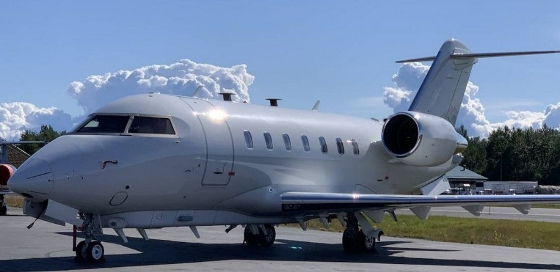 |
| March 05, 2024 | Volume 20 Issue 09 |
Designfax weekly eMagazine
Archives
Partners
Manufacturing Center
Product Spotlight
Modern Applications News
Metalworking Ideas For
Today's Job Shops
Tooling and Production
Strategies for large
metalworking plants
U.S. Army testing business jets for aerial surveillance and reconnaissance
By Staff Sgt. Jacob Kohrs with additional updates from U.S. Army News Service

Global 6500 jet aircraft. [Credit: Photo courtesy of Bombardier Defense]
The U.S. Army Contracting Command-Redstone Arsenal (Alabama), in coordination with the Army Fixed Wing Project Office, recently awarded a firm-fixed-price contract to Bombardier Defense (Learjet, Inc.) to procure one Global 6500 jet aircraft with options to purchase two additional aircraft over a three-year period. These aircraft will support prototyping efforts for the High Accuracy Detection and Exploitation System, also known as HADES. The Global 6500 standard configuration can hold 17 passengers, has a range of 6,600 nm, and has a top speed of 0.90 Mach (690 mph). Max operating altitude is 51,000 ft.
To help bridge the gap between decommissioning the old fleet and commissioning the new fleet, the ISR Task Force is using Aerial Technology Demonstrators, or ATD. ATDs are aircraft the Army is contracting as a service to test which airframes will work best for its mission requirements.
The HADES prototypes will be the first U.S. Army-owned large-cabin business jets utilized for Aerial Intelligence, Surveillance and Reconnaissance (ISR) platforms. The aim is for the aircraft to provide advanced deep-sensing capabilities for use in multidomain operations against peer and near-peer adversaries. The delivery date for the first aircraft is Oct. 1, 2024.
"HADES will bring the Army increased range, speed, endurance, and aerial ISR depth," said Col. Joe S. Minor, project manager for Army fixed-wing aircraft. "HADES will operate at higher altitudes than legacy turboprop platforms. Higher altitudes equate to an ability to sense farther and more persistently into areas of interest. Deep sensing is the number-one operational imperative for the Army of 2030."
In preparation for the HADES program of record, the Army first began purchasing aerial ISR as a service in the form of aerial technology demonstrators (ATDs) from defense industry vendors in 2020. The ATDs are providing data about platform performance, sensor integration, sensor performance, and data distribution to both the Army and the joint force. The ATDs also allow the Army to better understand the doctrine, training, personnel, facilities, and sustainment required to employ these more capable sensors and aircraft that HADES will provide.
The ISR Task Force started by looking at all joint, interagency, and allies' ISR programs and compared them to the Army's priorities. When the Task Force was finished, they decided on a large-cab business jet. This gave the Army the ability to group all the sensors on one plane with the ability to upgrade and/or add to those systems without losing performance. The first ATD was the airborne reconnaissance and target exploitation multi-mission system or ARTEMIS in 2020, said Capt. Jonathan Magee, ISR Task Force aerial planner for the Army Military Intelligence Staff.
"ARTEMIS was our first attempt at putting sensors on a jet to see how that was employed, and we put it in the [Indo-Pacific Command's Area of Operation] to see what it could do," Magee said. "All of it was good at the end of the day. It's informing the HADES POR, program of record, for what we need in the end."
During the first ATD tests, the ISR Task Force learned that the jets had longer flight times than the turboprops, which only had a five-to-six-hour flight time. The ATDs had a faster deployment capability and could travel anywhere in the world within 24 hours. They also flew higher and faster while allowing deeper sensor penetration.
After ARTEMIS' success in the Pacific, it was moved to the U.S. Army Europe and Africa. Here ARTEMIS showed its value.
"ARTEMIS demonstrated both the operational and financial value of the Army's future ISR concept, providing cross-combatant command support for its relatively new four-star theater commander with responsibilities that span tremendous geography across two continents," Paladino said. "No longer will the Army require multiple bed-down locations to access regional hotspots. A single aircraft with the speed and range of HADES can provide thousands of miles of reach from a single bed-down site, forward deployed."

ARES is part of the High Accuracy Detection and Exploitation System, or HADES program and is currently deployed in the Indo-Pacific Command's Area of Operation. [Credit: Courtesy Photo by U.S. Army]
In 2022, an additional ATD, Airborne Reconnaissance and Electronic Warfare System or ARES, was deployed to the INDO-PACOM Area of Responsibility. This aircraft was larger and closer to the HADES project's long-term goals.
"ARES revolutionized the Army's contribution to a joint fight in that theater," Paladino said. "ARES provides the [U.S. Army Pacific Command] an organic deep sensing capability with relevant collection capability for the modern battlefield. Adding additional altitude and persistence over ARTEMIS, ARES is competing nearly every day with the nation's most advanced adversaries. Just like with ARTEMIS, Army Soldiers operating in concert with the defense industry are providing this support to both Army and joint force commanders today."
Outside of the physical aspects of the jets being able to fly faster, longer, and higher, there has been some changes to the internal configurations the HADES project has built compared to the old turboprops.
"The one thing that I'm noticing is ... the ability to add different capabilities if necessary and being able to tailor them to whatever theaters we're in, which isn't really something we're able to do with the older platform," said Chief Warrant Officer 2 Amber Cornelius, the ARES processing, exploitation, and dissemination officer in charge with the 104th Military Intelligence Company; Processing, Exploitation and Dissemination (PED) Battalion, 116th Military Intelligence Brigade. "Some of the signals we are going after on an unclassified level in specific theaters, we weren't able to detect with the older platform. With these newer [platforms], just being able to go after those combatant commanders' top priorities has been one of the biggest game changers; especially going from a tactical focus to a more strategic focus."
With the diversity of the newer platforms, the PED Battalion had to change up their operations a little bit because going from a tactical focus to a strategic focus, the authority piece is different. Yet, it has allowed the Army to pick up the sensitive reconnaissance operations. Now, the PED is not only supporting the direct combatant commanders on the ground, but they are gathering for other government agencies, like the National Security Agency, Cornelius said.
Overall, the new ATDs have added capabilities that have helped make Army intelligence even more accurate.
"With the ability to fly higher, farther, and faster in the various target areas that we're looking at, we get vast amounts of data every mission that we fly. It is vastly different because we are able to stay in an area for a longer dwell time," said Sgt. Bryden Jones, a mission manager for ARES with the 104th Military Intelligence Company, PED Battalion, 116th Military Intelligence Brigade. "These capabilities allow us to provide things like pattern-of-life; it allows us to see up and down time locations, potential troop movement, or anything else you can think of."
ARTEMIS and ARES have the ability to see these things and push the information out to commanders in real time -- having instant and relevant intelligence, he said.
"Being able to relay that information is mind-boggling to me," he said.
As for building this fleet after the demonstration phase, the Army plans to make the first purchases in fiscal year 2024, Magee said. The plan is to have at least 14 aircraft eventually in as few geographic locations as possible to improve on training and force generation mission command, instead of the multiple locations where the turboprops are stationed now. By 2035, the PED unit will be fully equipped with Soldiers fully controlling operations.
As the Army builds the Army of 2030 by developing new equipment and adopting new concepts on how to fight the nation's wars, the HADES modernization efforts will take the Army into the new decade.
"This modernization effort, going from our legacy platforms to our current modern platforms, is absolutely a step in the right direction," Jones said. "We have stepped away from the counterterrorism operations and started looking at bigger, wider, more strategic objectives in order to effectively provide intelligence to the people that need the information to win the nation's wars. I never in my wildest dreams thought I would be a part of anything like this."
Following HADES will be the High-Altitude Platform-Deep Sensing (HAP/DS) as the next Multi-Domain Sensing System (MDSS) program of record. HAP/DS will comprise the high-altitude layer of the MDSS family of systems and will be an MDO-capable low-signature, high-altitude platform(s) (i.e., stratospheric balloons/solar fixed wing aircraft) operating in the stratosphere that will enable penetration into highly defended threat operational areas. The Army is currently in the campaign of learning stage for the program.

A conceptual image of high-altitude balloons (top) and high-altitude solar gliders (bottom) that will make up the High-Altitude Platform-Deep Sensing (HAP/DS) program. [Credit: U.S. Army graphic]
HAP/DS platforms may operate as individual platforms or in concert within a formation of platforms to provide sustained sensor delivery on target in support of long-range precision fires in operational and strategic deep fires areas. Once HAP/DS is deployed, it will provide multi-function sensor capabilities, including electronics intelligence, communications intelligence, SAR/MTI, and electro-optical/infrared with additional sensor capabilities in the future.
Published March 2024
Rate this article
View our terms of use and privacy policy
